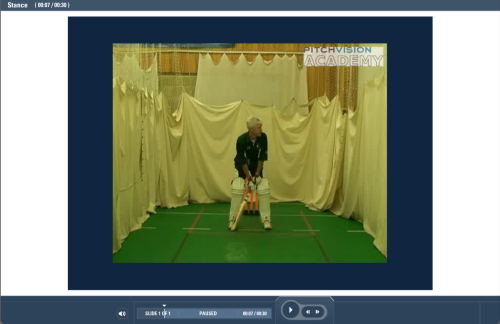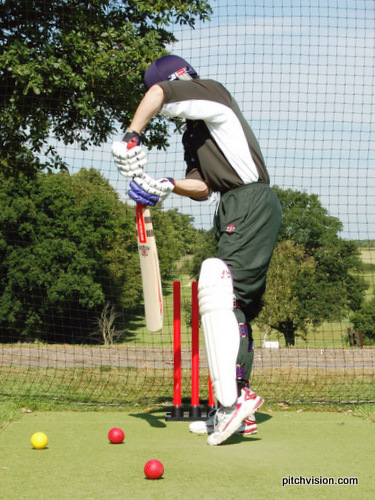How to exploit batting weaknesses: Width of stance
This is part of a series on How to exploit batsman's weaknesses. To see the other weaknesses click here.
Every good coach will tell their players to stand ready with their feet a comfortable distance apart. While this is usually about shoulder width, some players will stand differently.
The modern trend is to stand with a wider stance than the coaching book recommends (like Chris Gayle or Graeme Smith), but there are also players who follow the Jack Hobbs method of keeping the feet close together.
At club and school level, these technical flaws lead to errors.
In his course: "Improve Your Batting With Simple Changes to Your Setup", Gary Palmer explains why the having a wide or narrow stance is a weakness.
You can view that portion of the video and see what the side and narrow stances look like by clicking here.
- A wide stance makes it difficult to move your feet quickly.
- A narrow stance makes it difficult to stay balanced, increasing your chances of toppling over.
A wide stance is a batsman's way of hedging his or her bets. It allows you to play with less footwork because you have gone both forwards and back without moving. As a result it's favoured by big hitters who like to 'stand and deliver'.
If you are bowling to one of these players, the way to take advantage is to get the batsman 'feeling' for the ball.
This means extracting as much movement as possible through the air or off the pitch. The sluggish footwork means the batter is slow to get in position which increases the chances of edging the ball.
Outswing and the ball spinning away from the bat is the best way of doing this as the feet of the batsman don't move, but the bat follows the ball leading to the bat moving sideways away from the body and a loss of control (this is sometimes called "curtain-railing").
You can see the batsman in the wrong position on the back foot here:
As you can see, the full face of the bat is not at the ball and it hit being hit square, allowing you to set squarer fields and plenty of off side catchers behind the bat.
Inswing and the ball spinning in can exploit the slow feet for catching batsmen LBW.
Spinners have a special advantage over the wide stance player. As they are more likely to get stuck flat footed they are especially vulnerable to the ball above the eye-line that dips late in flight.
Outwitting the narrow stance
Although less popular these days, the narrow stance batsman can survive in lower level cricket where the bowling is slower and the wickets less bouncy.
However, the base is less stable meaning the batter will favour playing on the back foot (because it's easier to sit back than lean forward and topple over).
So as bowler your best approach is to pitch the ball up a fuller length on or just outside off stump.
The unbalanced position going forward makes it harder for the batsman to know where the off stump is. He ends up playing at wide balls or getting closed off when playing at straighter balls and playing with half a bat.
Also, it's much harder for him to drive the ball along the ground from this unstable position, so close catchers in front of the wicket (short extra cover and short midwicket) are excellent fielding positions.
Want to improve your skills so you can bowl to these tactics or iron out your batting weaknesses? PitchVision Academy has an online coaching course to help you from the world's finest coaches.
- Login to post comments




Comments
Very interesting article
nice information, Thanks God that I have a standard stance with the normal length (about bat's width).
For whatever reason, since being injured as a bowler and becoming a batsman i've changed my stance to being fairly wide (not 'Chris Gayle wide' but still wide) in the past month or so. I think it just feels 'stable'. Felt and looked pretty good when I used it against medium pacers and spinners both in the nets and in two inningss, but was shunted up to open the other other day and just could not get going at all against two pretty nippy opening bowlers*. Am absolutely going back to shoulder width at practice tomorrow. Might stand outside my crease a bit too, just to simulate playing 'fast' bowling as there isn't really anyone in my team who does so!
*They didn't get me though - their medium pacers came on, nudged them for six fours and then hit one straight to point, am off to look for 'remembering where the fielders are' posts!
You might want to experiment with the 'back and across' movement too.
Thanks David yes it's definitely a thought, though that does require a bit more getting used to. May give it a try if i'm scratchy again.
A lot of it is about how it feels, of course you still need to be well balanced and keep good shapes but after that it has to feel right. Sometimes getting used to something takes some practice.
thing is, we say these are technical errors, but at the level i play, there are 30 and 40 year olds who have been playing the way they have been since they were 10.
its a bit like the point i raised about paul collingwood and his low backlift, theyv been playing so long with that technique that they have adapted their game plan around it, if u see what i mean.
this season, we played agaisnt a team whos number 5 batsman held his bat more towards point than off stump.
what would you have done? bowled outside off stump? thats what we thought, but he scored a 50
we faced that side again a few weeks later. he scored another 50.
I use both a wide and narrow stance is this a good thing to do?
No, keep your stance the same all the time to be consistent.
which one would you recommend.
An orthodox stance is the best. Use what feels most comfortable and allows you to move forward or back easily.
Thanks